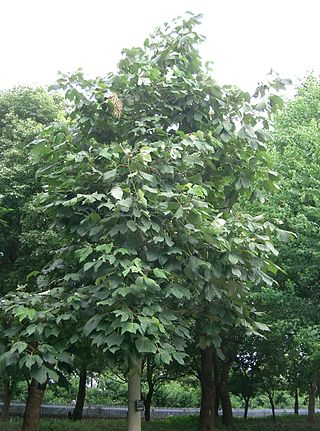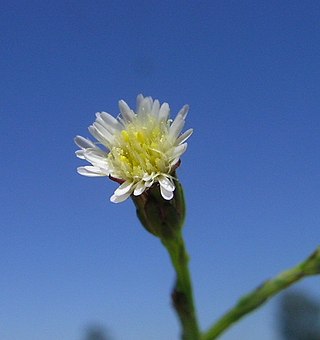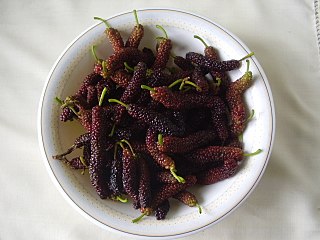
Ulmus castaneifoliaHemsley, the chestnut-leafed elm or multinerved elm, is a small deciduous tree found across much of China in broadleaved forests at elevations of 500–1,600 metres (1,600–5,200 ft).

Ulmus macrocarpaHance, the large-fruited elm, is a deciduous tree or large shrub endemic to the Far East excluding Japan. It is notable for its tolerance of drought and extreme cold and is the predominant vegetation on the dunes of the Khorchin sandy lands in the Jilin province of north-eastern China, making a small tree at the base of the dunes, and a shrub at the top.

Firmiana is a genus of flowering plant in the family Malvaceae, formerly placed in the now defunct Sterculiaceae; it may sometimes be called the "parasol tree". The genus name honours Karl Joseph von Firmian.
Isolona congolana is a species of plant in the Annonaceae family. It is found in the Democratic Republic of the Congo and Uganda. It has also recently been found in southern Africa.
Isolona dewevrei is a species of plant in the Annonaceae family. It is endemic to the Democratic Republic of the Congo. It is threatened by habitat loss.

Xylopia africana is a species of plant in the Annonaceae family. It is found in west-central Africa. It is restricted to submontane and lower montane forests. It is threatened due to habitat loss by clearance of forest. It was first described as Melodorum africanum in 1862 by George Bentham.

Ficus americana, commonly known as the West Indian laurel fig or Jamaican cherry fig, is a tree in the family Moraceae which is native to the Caribbean, Mexico in the north, through Central and South America south to southern Brazil. It is an introduced species in Florida, USA. The species is variable; the five recognised subspecies were previously placed in a large number of other species.

Ulmus parvifolia, commonly known as the Chinese elm or lacebark elm, is a species native to eastern Asia, including China, India, Japan, Korea, and Vietnam. It has been described as "one of the most splendid elms, having the poise of a graceful Nothofagus".

Allium macrostemon, Chinese garlic, Japanese garlic or long-stamen onion, is a species of wild onion widespread across much of East Asia. It is known from many parts of China, as well as Japan, Korea, Mongolia, Tibet and Primorye. It has been collected from elevations ranging from sea level to 3000 m.

Symphyotrichum subulatum, commonly known as eastern annual saltmarsh aster or, in Britain and Ireland where it is naturalized, annual saltmarsh aster, is an annual plant in the family Asteraceae native to the eastern United States and the Gulf Coast to Texas. The species grows primarily in coastal salt marshes, although in the Ozarks it occurs as a non-marine weedy variety.

Morus macroura, also known as the king white mulberry, shahtoot mulberry, Tibetan mulberry, or long mulberry is a flowering plant species in the genus Morus found in Tibet, the Himalayas, mountainous area of Indonesia, and rain forests of Indochina. It is a medium-sized tree, with a spreading canopy which grows with a weeping habit. Ripe fruit is white, pink or red, and is described as honey-sweet.
Quercus petelotii is the accepted name of an endemic oak tree species in the Asian sub-genus of 'ring-cupped oaks' and the family Fagaceae; there are no known sub-species.

Sterculia lanceolata is a tree species, belonging to the genus Sterculia and the family Malvaceae. The species can be found in southern China and Vietnam.

Sterculia africana or African star-chestnut is a deciduous tree, belonging to the genus Sterculia and the family Malvaceae. The species is sometimes called the "mopopaja tree". It is distributed throughout Northeast Africa to Arabia.

Anisoptera thurifera is a tree species in the family Dipterocarpaceae. This Asian species has been recorded from Bangladesh through to New Guinea; the IUCN has categorised it as Vulnerable.
Dalbergia stipulacea is a species of small tree, with the Vietnamese name trắc lá bẹ. The genus Dalbergia is placed in the subfamily Faboideae and tribe Dalbergieae.

Terminalia calamansanai, also spelled Terminalia calamansanay, is a species of plant in the family Combretaceae. It has a large range in SE Asia, from Bangladesh to New Guinea.

Pterocymbium tinctorium is a tropical forest tree species in the family Malvaceae, subfamily Sterculioideae. In Vietnam, it is known as dực nang nhuộm. In Indonesia, it is called kelumbuk, where it is a significant timber tree growing to about 25 m high. In the Philippines it is called malasapsap.
Parishia is an Asian plant genus in the family Anacardiaceae, subfamily Anacardioideae. It is found in Indo-China and Malesia; no subspecies are listed in the Catalogue of Life. It was named in 1860, by Joseph Dalton Hooker, in honour of the botanist and plant collector Charles Samuel Pollock Parish.

Harrisonia is a small genus of flowering plants in the subfamily Cneoroideae of the Rutaceae. Older taxonomic treatments have placed this genus in the Simaroubaceae.















